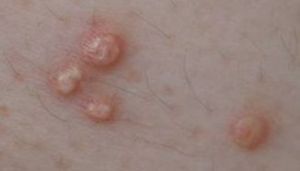

MedFriendly®


Xanthoma
A xanthoma (pronounced zan-tho-muh) is a tough,
painless, non-cancerous, deposit of fat that
develops beneath the skin. Xanthomas are also
composed of cells in the connective tissues known
as histiocytes. A cell is the smallest, most basic unit
of life, that is capable of existing by itself.
Histiocytes are capable of surrounding and
digesting tiny organisms and waste from cells. Cells
carry out the chemical processes that are
necessary for life to exist.
Xanthomas.
FEATURED BOOK: Skin Rules: Top Secrets from a Top New York Dermatologist
WHAT DO XANTHOMAS LOOK LIKE?
Xanthomas can appear pink, yellow, or skin-colored. Xanthomas take the appearance of
plaques, nodules, or tumors. Plaques and nodules are both areas on or in the body that
appear different from other tissue, with nodules and tumors appearing more swollen.
Tumors are tissues that grow more rapidly than normal. Xanthomas can be very small or
as large as three inches.
WHERE DO XANTHOMAS OCCUR?
Xanthomas can occur anywhere on the body, but are commonly found on the knees,
elbows, hands, feet, buttocks, joints, and tendons (groups of fibers that attach muscles to
a bone).
"Where Medical Information is Easy to Understand"™
WHAT CAUSES XANTHOMAS?
Abnormal levels of fat in the blood usually lead to the development
of xanthomas. Specifically, xanthomas are characterized by a
buildup of chemical substances in the body known as cholesterol
and cholesterol esters. Cholesterol is a waxy, fatty substance found
only in animal tissues. Cholesterol esters are a group of fatty
substances formed by the bonding of alcohol and one or more types
of acids that contain the element, carbon. When there is too much
fat in the blood, specialized cells in the skin and tissues "eat" some
of the extra fat. As the fat builds up, xanthomas appear and become
larger.
HOW ARE XANTHOMAS TREATED?
Xanthomas can be removed with surgery, but they may reappear. If there are any underlying disorders
that are contributing to the development of xanthomas, the goal will also be to treat the underlying
condition. Adjusting the diet to control the level of fats and cholesterol in the blood is another approach
that doctors often use to treat xanthomas. It is nearly impossible, however, to eliminate all fat or
cholesterol from the diet. Thus, a low fat diet, as opposed to a no fat diet, is the most realistic option.
Exercise is also an important aspect of treatment because it can decrease the level of fat in the blood.
WHAT IS THE DIFFERENCE BETWEEN XANTHOMA AND YELLOW FEVER?
Yellow disease is the occurrence of yellow colored patches in the skin that resemble a condition known as
xanthoma. Whereas xanthoma on the skin takes the form of yellow plaques or nodules, yellow disease
does not. Plaques and nodules are both areas on or in the body that appear different from other tissue,
with nodules being more swollen and bumpy. In this sense of the word, yellow disease is also known as
yellow skin, xanthochromia, xanthoderma, cholesterodoma, xanthochroia, and xanthopathy.
WHAT IS THE ORIGIN OF THE TERM, "XANTHOMA"?
Xanthoma comes from the Greek word "xanthos" meaning "yellow," and the Greek word "oma" meaning
"tumor." Put the two words together and you have "yellow tumor."















